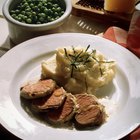
Part of the appeal of frozen schnitzel and similar convenience products is that they lend themselves to cooking straight from the freezer. The breaded coating provides a dual-purpose protective shell, guarding the thin cutlets from toughening in the heat and trapping steam to speed the cooking process. The crisp, golden breading also adds substantially to the schnitzels' appeal, either oven-baked or pan-fried.
Oven Preparation
Step 1
Preheat your oven to 400 degrees Fahrenheit.
Step 2
Count out as many frozen veal, pork, turkey or chicken schnitzels as are required for your meal. Arrange them on a parchment-line baking sheet, with at least 1/4 inch of space between the schnitzels.
Step 3
Brush or spray the schnitzels lightly with oil. This step is optional, but helps the crumb coating to brown and crisp in the oven.
Step 4
Bake the schnitzels for 20 to 25 minutes, or until an instant-read thermometer inserted horizontally through the edge of the schnitzel shows in internal temperature of 165 F. Turn the schnitzels midway through their cooking time to ensure even cooking and a crisp, golden coat on both sides.
Step 5
Serve hot with your choice of side dishes.
Skillet Preparation
Step 1
Place one or more heavy skillets on your stovetop over medium-high heat. Pour in enough oil to cover the bottom of each skillet to a depth of at least 1/4 inch.
Step 2
Place the frozen schnitzels in the preheated pans, arranging them so the skillets are not crowded and there's plenty of space between the portions. The hot fat will tend to spatter, so it's best to use tongs or a glove to protect your hand.
Step 3
Reduce the heat to medium, and cook the schnitzels for 5 to 6 minutes or until they're crisp and deeply golden on the first side.
Step 4
Turn the schnitzels and cook them for another 5 to 6 minutes, then remove them from the heat and let them rest for 2 to 3 minutes. An instant-read thermometer inserted horizontally into the thickest part of the schnitzel should read 165 F.
Step 5
Serve the schnitzels immediately, before the steam emerging from the meat has time to soften the crisp crumb coat.
Related Articles

How to Cook Pork Chops on an Electric ...

How to Cook a Frozen Beef Patty ...

How to Freeze Empanadas

How to Deep-Fry Frozen Potstickers

How to Cook Japanese Teppanyaki

How to Keep Breaded Pork Chops Crispy ...

How to Deep-Fry Chicken Nuggets

How to Fry Cauliflower Patties

How to Cook a Frozen Burger in a Skillet

How to Pan Cook Shark

How to Cook Barbecue Chicken Drumsticks ...

How to Bake Breaded Mahi Mahi

How to Cook Marinated Pork Loin From a ...

How to Cook Swai With Breading

How to Cook Venison Steaks With Onions

How to Cook Venison Inside Loin

How to Roast Italian Sausage

How to Cook Tender Rolled Flank Steaks ...

How to Keep Breaded Baked Pork Chops ...

How to Cook Homemade Crabcakes in the ...
References
- Professional Cooking; Wayne Gisslen
- Ingham Foodservice: Chicken Schnitzel Product Information
Resources
Tips
- Oven preparation uses less oil and is more convenient for a large number of schnitzels, while skillet preparation is quicker and easier for only one or two portions. If you need to prepare several schnitzels on the stovetop, do no more than one or two in each skillet and keep them warm in the oven while the remainder are cooking.
Writer Bio
Fred Decker is a trained chef and prolific freelance writer. In previous careers, he sold insurance and mutual funds, and was a longtime retailer. He was educated at Memorial University of Newfoundland and the Northern Alberta Institute of Technology. His articles have appeared on numerous home and garden sites including GoneOutdoors, TheNest and eHow.
Photo Credits
John Foxx/Stockbyte/Getty Images